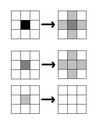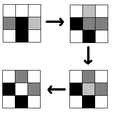GCPP:Proposal-Bullhead
Puzzle Codename: Bullhead
| Contact | |
| Username: | Karein |
| Additional contact info: | email: afink@ups.edu, Karein on the Hunter Ocean, AIM as griffer13524 |
| Project forum thread: | Discussion |
Game concept
A puzzle meant to simulate blacksmithing. As far as I know, it's an original puzzle, but it borrows a little from an old game I played called Chain Reaction.
Objective
The goal is to manipulate the bar of metal so that it fills in the given pattern before the metal cools and hardens.
Gameplay
The player uses a hammer to hit different parts of the bar of iron, which has been divided into grid like portions. Depending on where the bar is hit, the metal spreads in different directions. The metal can be of four thicknesses, signified by its color. Black is the thickest, then dark gray, light gray, and then clear, or a hole.
- Each time a square is hit, that square decreases by one thickness level.
- Each time a black or dark gray square is hit, the four adjacent squares increase by one thickness level.
- A square can only increase the thickness of an adjacent square if and only if the square is of a lower thickness level. For example, a dark gray square, if hit, can increase the thickness of a clear square to light gray, or of a light gray square to dark gray, but it can't increase a dark gray square to black, that square is unaffected.
- When a light gray square is hit, the metal does not spread, instead the piece shatters leaving a clear space.
All of these rules are illustrated in the images below.
The playing field is the blacksmith's anvil, on which there is a shadowed outline of the finished shape. The ultimate goal is to draw the metal out of the bar and fill the shape in exactly. A secondary goal is to even the metal out to the desired thickness of the item that is being smithed. For example, if the outline is of a blade, the goal would be to make the edges thin, and the middle moderately thick. If it were a hilt, the metal would want to be the same uniform thickness throughout the pattern.
Scoring
Players would be scored for how accurately they matched the shape, how accurately they leveled the metal to the desired thickness, and how quickly they finished the puzzle.
Variability
The players could receive bonus pieces which allow them to raise the thickness of a section by welding on a second piece of metal. Variability could also be achieved by varying different starting blocks of iron. Certain grid pieces could light up and gain a bonus if they are struck in a certain amount of time. Advanced players could be allowed to reheat an object, allowing them to continue a difficult pattern. The repercussions of this could be that the object thickness randomizes slightly, or the shape warps.
End criteria
The game would continue until either the player is satisfied with the product, or when the timer runs out, indicating that the metal has cooled.
Difficulty scaling
More advanced players would be given larger and more complex patterns. While beginners may start working with hilts and blades, more advanced players may make rings, chains, or metal parts of furnishings and ships.
Crafting type
This would be a blacksmithing puzzle, though it could work as part of a furnishing puzzle.
Known problems
The hardest part would be creating patterns and judging their difficulty levels. While there are plenty objects to model, it would take a lot of testing to accurately gauge how much time it will take to finish the patterns. The patterns would be hard to randomize for the same reasons, and players may run into repetition eventually. The rules may be confusing to explain to newcomers.
Notes
Images


